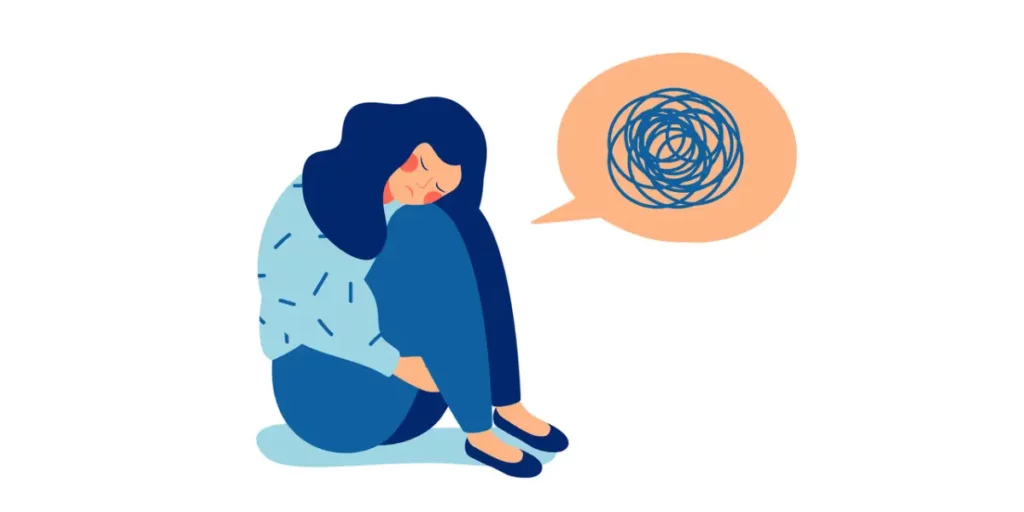For those diagnosed with Generalized Anxiety Disorder (GAD), these feelings are not just occasional but are a constant companion. Fortunately, there’s hope. Cognitive Behavioral Therapy (CBT) has emerged as one of the most effective treatments for GAD. In this blog post, we’ll delve into the application of CBT for GAD, and how it offers a pathway to a life with reduced anxiety and increased overall well-being. Whether you’re considering CBT for yourself or simply wish to understand its potential benefits, this guide is for you.
Contents
Can CBT Help With Generalized Anxiety?
 Cognitive Behavioral Therapy (CBT) is a well-established and extensively researched therapeutic approach. It has proven effective in treating a range of psychological disorders, including Generalized Anxiety Disorder (GAD). CBT for GAD primarily focuses on identifying, understanding, and changing negative thought patterns and behaviors that contribute to chronic anxiety.
Cognitive Behavioral Therapy (CBT) is a well-established and extensively researched therapeutic approach. It has proven effective in treating a range of psychological disorders, including Generalized Anxiety Disorder (GAD). CBT for GAD primarily focuses on identifying, understanding, and changing negative thought patterns and behaviors that contribute to chronic anxiety.
The therapy aids in equipping individuals with practical skills to manage their anxiety and cope with stressful situations more effectively. When it comes to success rates, studies have consistently shown that CBT is particularly beneficial for those with GAD.
A comprehensive review of clinical trials indicated that between 40% to 60% of patients with GAD show significant improvement after undergoing CBT. Moreover, the benefits of CBT often endure long after the completion of therapy, with many individuals maintaining their gains and reporting decreased anxiety levels even years post-treatment.
How Is CBT Used To Treat Generalized Anxiety Disorder?
Cognitive Behavioral Therapy (CBT) is a structured, goal-oriented therapy that targets the maladaptive thought patterns and behaviors associated with generalized anxiety disorder (GAD). When using CBT to treat GAD, therapists incorporate several core strategies:
- Education
One of the first steps is educating the patient about GAD. This includes understanding the symptoms, how they affect the mind and body, and the role of negative thought patterns in perpetuating anxiety.
- Self-monitoring
Patients are taught to recognize and record their anxious thoughts, situations that trigger anxiety, and their emotional and physical reactions. This helps in identifying patterns and understanding the relationship between thoughts, emotions, and behaviors.
- Cognitive Restructuring
This is the process of identifying and challenging negative or irrational thoughts that contribute to anxiety. Patients learn to recognize distorted thinking patterns and are taught ways to replace them with more balanced and realistic thoughts.
- Exposure Therapy
Though more commonly associated with specific phobias or PTSD, it can also be used for GAD. This involves gradually and repeatedly exposing the patient to the source of their anxiety in a controlled setting to reduce their fear and discomfort.
- Behavioral Activation
Encouraging patients to engage in pleasurable, fulfilling activities can help distract them from their anxieties. And can act as a counterbalance to the avoidance behaviors often seen in GAD.
- Skills Training
This can include time management, assertiveness training, or other skills that can help reduce anxiety in specific situations.
- Homework Assignments
Between sessions, patients might be given assignments to practice the skills they have learned. This could be as simple as practicing deep breathing techniques, recording anxious thoughts in a journal, or confronting a situation they’ve been avoiding.
Through these strategies, CBT addresses the underlying cognitive distortions and maladaptive behaviors associated with GAD. Over time, with practice and guidance, many individuals find significant relief from their symptoms, leading to improved overall well-being.
Benefits Of CBT For Generalized Anxiety Disorder
 The following are the key benefits of using CBT for GAD:
The following are the key benefits of using CBT for GAD:
- Evidence-Based Treatment: CBT is grounded in empirical research, with numerous studies demonstrating its effectiveness in treating GAD and reducing symptoms.
- Skill Development: CBT provides individuals with practical skills to manage their anxiety. These skills, once developed, can be applied in various life situations, empowering the individual to handle stressors more effectively.
- Short-Term Treatment: Unlike some forms of therapy that may continue indefinitely, CBT is typically a short-term treatment. Many individuals experience significant improvement within 12 to 20 sessions.
- Focus on the Present: While understanding the past can be beneficial, CBT emphasizes current thought patterns and behaviors. This here-and-now focus helps patients address immediate concerns and challenges.
- Structured Approach: CBT sessions are goal-oriented and structured, providing clear direction and purpose in each meeting, which can be motivating for many patients.
- Reduction in Medication: For some individuals, effective CBT can lead to a reduction or even discontinuation of anti-anxiety medications (under the guidance of a physician).
- Improved Self-esteem: As individuals learn to control their anxiety and challenge negative thought patterns, they often experience a boost in confidence and self-worth.
- Addressing Coexisting Conditions: CBT is also effective in treating other coexisting conditions, such as depression or social anxiety, providing comprehensive mental health support.
- Enhanced Self-awareness: Through the process of identifying and challenging distorted thoughts, individuals gain insight into their own minds, leading to greater self-awareness and understanding.
- Empowerment: CBT shifts the locus of control to the individual, empowering them to be active participants in their recovery.
As you can see, CBT for GAD offers a multifaceted approach, providing symptom relief. And also tools and strategies that individuals can integrate into their daily lives for lasting well-being.
How To Get Started With CBT For GAD?
 If you’re considering Cognitive Behavioral Therapy (CBT) for Generalized Anxiety Disorder (GAD), taking the initial steps can feel daunting. However, with the right approach, you can seamlessly integrate CBT into your journey toward better mental health. Here’s a step-by-step guide to getting started:
If you’re considering Cognitive Behavioral Therapy (CBT) for Generalized Anxiety Disorder (GAD), taking the initial steps can feel daunting. However, with the right approach, you can seamlessly integrate CBT into your journey toward better mental health. Here’s a step-by-step guide to getting started:
Educate Yourself
Before embarking on any therapeutic journey, it’s pivotal to understand the process. Familiarize yourself with the principles and methods of CBT. By grasping how CBT is designed to treat GAD, you’ll be better prepared to actively engage in the therapy. There are numerous resources, both online and in print, that offer insights into CBT, its techniques, and its applications for anxiety disorders.
Consult a Primary Care Physician
Starting with a primary care doctor can be a logical first step. They can provide a preliminary assessment of your symptoms, ensuring you’re on the right track. Moreover, they can often offer referrals to reputable mental health professionals and clinics specializing in CBT, making the next steps of your journey more streamlined.
Find a Therapist
Seeking a qualified therapist is crucial. Whether you’re exploring directories, asking for personal recommendations, or checking with insurance providers, ensure that the therapist has a background in CBT and experience with GAD. The right fit can make a world of difference in your therapeutic experience.
Check Credentials
Ensuring that your potential therapist is licensed and credentialed is non-negotiable. It’s essential for your safety and ensures you’re receiving a standard of care that adheres to professional guidelines. Inquire about their training, specializations, and experience specifically with GAD.
Initial Consultation
The first session is often exploratory. It’s a chance for both you and the therapist to determine if the therapeutic relationship is a good fit. You can present your concerns, understand their therapeutic approach, and set initial expectations. This session lays the groundwork for subsequent meetings.
Set Clear Goals
Having a direction in therapy is vital. Collaborate with your therapist to define what you hope to achieve – whether it’s symptom reduction, improving coping skills, or enhancing overall well-being. These goals serve as a roadmap, guiding each session and ensuring progress.
Commit to the Process
Active participation is key. CBT is often hands-on, requiring you to undertake assignments or exercises outside the therapy room. These tasks, designed to reinforce session learning, are integral to the therapy’s success. Your dedication can significantly amplify the therapy’s benefits.
Stay Open-minded
Therapy, by nature, can challenge deeply ingrained beliefs and thought patterns. Approach each session with an open mind. Being receptive to new perspectives and willing to test out different strategies can foster greater personal growth and therapeutic progress.
Consider Group Therapy
While individual sessions offer personalized attention, group therapy brings a communal aspect. Sharing experiences, hearing others’ stories, and receiving peer support can be incredibly enriching for some individuals, adding a different dimension to the therapeutic process.
Monitor Progress
It’s beneficial to periodically review your progress with your therapist. Reflecting on your journey, celebrating milestones, and recalibrating goals ensures that therapy remains effective and responsive to your evolving needs. And further, CBT doesn’t end when sessions conclude. Work on a post-therapy plan with your therapist, ensuring you have tools and strategies to maintain the gains you’ve achieved and handle future challenges.
In essence, initiating CBT for GAD is a thoughtful process. From the preliminary stages of education to post-therapy maintenance, each step is crucial in ensuring you receive the best care, tailor-made to your needs.
Conclusion
In the journey to address and manage GAD, CBT stands as a beacon of evidence-based, effective treatment. Therefore, embarking on this therapeutic pathway requires an informed and proactive approach. That could range from selecting the right therapist to actively participating in sessions and beyond. By understanding the nuances of CBT, setting clear goals, and committing to the process, individuals can harness its profound benefits.
Ultimately, they can transform their relationship with anxiety and pave the way for a life of greater calm, confidence, and well-being. If you are experiencing anxiety-related issues, Online Anxiety Counseling at TherapyMantra can help: Book a trial Online therapy session


